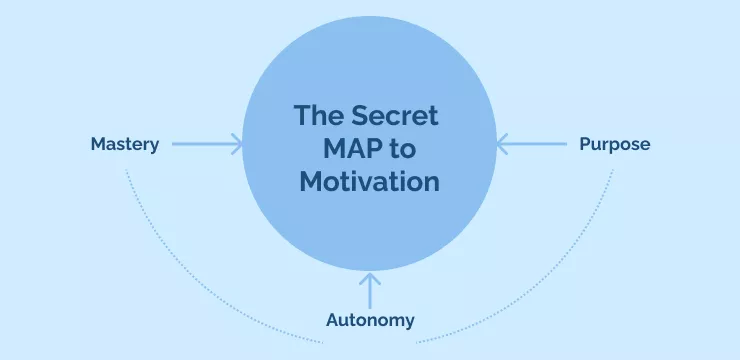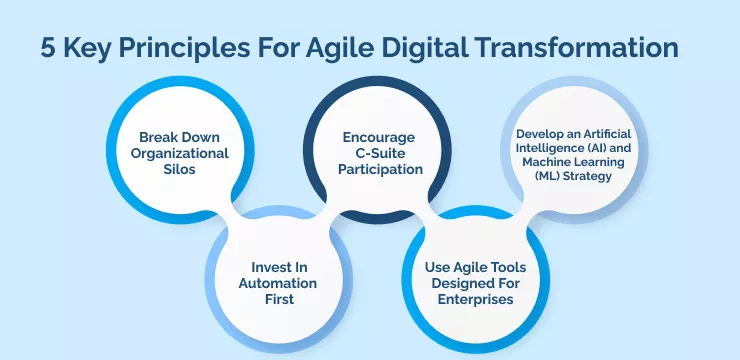
Done correctly, Agile unlocks the true potential of a team.
How do you ensure your agile teams perform at their best when traditional performance management methods are strictly undermined by the Agile principles laid out in any Scrum Master guide?
The carrot and the stick is old hat, and employees are not donkeys. They’re human beings. Your Agile team members know it. It’s important to understand that their motivation should come from the desire to produce quality work and not from the fear of punishment or reward.
Building trust among team members is key to getting a successful Agile team. When employees trust each other, they naturally start working together toward their goals. It also helps to focus on change management initiatives that focus on helping team members adjust to the new work environment.
But how far should a Scrum master go to keep the entire team happy and productive?
What Is Team Agility In Business?
If you want to be a leader who can motivate people and lead a team to success, you must understand the role of agility in a work environment.
Team agility uses Agile practices like Scrum and Kanban within a production team. The goal is to create a team that is highly resilient to change.
Rather than shying away from changes, an Agile team sees opportunities for success.
Usually, a highly Agile team will work with a consistent cadence. They’ll be highly autonomous and able to self-organize.
Why Team Agility Is Key For Business Transformation

Covid-19, market crashes, The Great Resignation.
These are just some unexpected challenges businesses have faced in the last few years.
Businesses with agility retained a competitive advantage over the pandemic while traditional companies scrambled to get their entire team up and running with remote work.
Team agility is the best way to ensure productivity and stakeholders stay happy.
The Importance Of Agile Business Practices
Recent analysis from McKinsey suggests that the COVID-19 crisis widened the gap between the top economically performing companies and their competition.
Another McKinsey report indicates that the top 20% of companies now capture 95% of economic profit and that those companies have been focused on developing Agile business practices.
The pace of change in digital industries has far exceeded the capabilities of traditional businesses to adapt. That’s why we need Agile.
The Secret MAP to Motivation

In “Drive: The Surprising Truth About What Motivates Us,” author Daniel H. Pink explains that the three key elements of motivation are Mastery, Autonomy, and Purpose. M.A.P.
- Mastery — people see no limits to their potential and are given the tools they need to continue to improve their skills.
- Autonomy — people are trusted and encouraged to take ownership of their work and skill development.
- Purpose — people are encouraged to use their skills to achieve a “greater” goal.
Understanding this gives managers a solid foundation for increasing team motivation, but how about more practical steps?
6 Ways To Spark Inspiration Amongst Your Agile Team

Whether you’re a project manager, product owner, Agile coach, or Scrum master, you have a part in creating a work environment that inspires agility.
Here are just a few things you can do to keep team motivation high:
1. Communicate Strategic Goals Across The Organization
Managers should make it clear what they expect. Stakeholders should be kept in the loop.
Communicating goals across the organization help managers protect their teams and cement their identity—giving them a sense of purpose.
2. Cultivate A More Confident Learning Culture
Develop a company culture where asking questions and making mistakes is normal.
Enable employees to take courses. Encourage scrum teams to mentor one another, even cross-organisationally.
People love to learn. Give a scrum team an environment that supports their continued improvement, and the team’s motivation will rise.
3. Incentivize Employee Milestones
To keep your teams motivated, you must see the person, not just the employee.
Employee milestones are events that celebrate accomplishments at work. This can range from the completion of a significant project to a promotion. Make these events feel special.
In an Agile setting, this is easy. You don’t have to wait for a project to be completed to celebrate success.
Scrum is one of the most common Agile methodologies for a development team, and one of the critical features of Scrum is that work is completed in “sprints.”
The benefit is major projects are broken down into small, digestible chunks of work. You can use these small milestones to inject positive emotions into your scrum meetings.
4. Be Open To Criticism and Constructive Feedback
Agile development methodologies include plenty of tactical meetings like a daily scrum. Then there are the longer meetings like sprint planning— these are excellent opportunities for scrum masters and managers to talk to their teams and listen.
It’s important to consider that not everyone is comfortable giving feedback in public, so when you talk to team members 1-on-1, make sure you take the time to listen to their ideas about where improvements could be made.
5. Acknowledge and Reward Accomplishments
It doesn’t take much to make employees feel recognized for their efforts. Yet, many businesses fail to do so often because the actions of operational teams aren’t seen or fully understood by those in leadership.
Scrum masters should communicate all the work a team is doing to stakeholders.
On top of that, allow employees to nominate one another for recognition rewards. This has the added benefit of promoting good relationships within the team.
Acknowledgment of a team’s hard work and the value they create fosters an environment of positive emotions, and it’s a great way to motivate teams.
6. Cultivate Team Independence and Autonomy
The Agile manifesto reads: “Build projects around motivated individuals.”
You can take this further by allowing Agile teams to decide how they work through the product backlog.
You must also protect them from other affronts to their autonomy and independence.
Product owners and project managers making decisions about a software development team’s workload is usually a recipe for disaster. Scrum masters should shelter their teams from scope creep and prohibitive deadlines. Consider including a representative from the team in these kinds of discussions.
The Inherent Problem describes how the biggest waste of time in an organization is the requirement of leadership to approve decisions. Wherever possible, you want to remove this blocker and allow Agile teams to operate autonomously.
One of the best ways for a scrum master to support a team is to protect them.
Key Skills Agile Leaders Need To Sustain Team Agility
People over processes – Processes help provide guidance, but using them more like a compass than a map is better. You should rely on your team’s expertise to get you to your destination.
Qualitative and quantitative data – Hard data and metrics are robust but slow to collect. Qualitative data is usually formed faster. You’ll need to be able to use both when measuring employee experience.
Accept Good Enough – The Minimum Viable Product (MVP) concept is an effective Agile strategy in software engineering. Be willing to launch a bare minimum product, collect data, then reiterate and repeat. Chasing perfection yields diminishing returns, and you don’t have time for it in an Agile environment.
Be Flexible – Keeping productivity high requires adapting to new challenges.
Agile is iterative. Be willing to try things out, take risks, and test theories.
What Is Motivation And Why Is It Important For Positive Business Outcomes?
Motivation is what makes us want to do things. It’s an emotion.
It’s something we need to get things done, and it’s also something we seek. Motivation itself is a “good feeling.” It’s something we crave more of.
For businesses, it’s a primary driver for loyalty, productivity, and morale.
A motivated workforce is more effective at creating value. Employee turnover is reduced, which in turn, reduces costs.
Motivation throughout an organization helps build momentum, which translates to an increased growth rate.
Extrinsic vs. Intrinsic Motivation
not all forms of motivation have an equal impact on job performance.
Intrinsic motivation comes from within. You might decide to achieve a goal and accepting that responsibility motivates you to work towards it. Or, you may enjoy the feeling of a good day’s work.
Extrinsic motivation comes from outside the self, for the desire for a reward or for the desire to avoid punishment. An extrinsically motivated worker gets the job done because that’s the expectation of their manager. Or because they want a bigger end-of-year bonus.
A study by MBIA Journal found that intrinsic motivation had a much more significant positive effect on job performance than extrinsic motivation.
So, while employees should be offered extrinsic motivation through bonuses and recognition, promoting a culture that intrinsically motivates employees is much more impactful.
5 Key Principles For Agile Digital Transformation

- Break Down Organizational Silos
You want your value stream to flow as smoothly as possible. Organization-wide communication, creating cross-functional teams, and good company culture are all effective ways to break down the walls between teams.
- Invest In Automation First
An automation strategy allows an organization to rethink its approach to business functions.
You can break complex functions into smaller ones like development, data analysis, or feedback collection. You can then automate the more specific processes, freeing highly skilled workers to focus on challenging and motivating tasks.
- Encourage C-Suite Participation
Transformation must happen from the top down.
Agile digital transformation requires autonomy among Agile teams. If shifting to an Agile structure from a more traditional one, the power to make autonomous decisions will have to be relinquished by management at the top level.
- Use Agile Tools Designed For Enterprises
The right tools can make Agile digital adoption a much smoother process. There’s plenty of software out there that helps businesses set up Kanban or Scrum boards and promote Agile.
Then there are digital adoption platforms (DAP) like WalkMe, which makes learning to use new applications easy, accelerating your digital transformation.
- Develop an Artificial Intelligence (AI) and Machine Learning (ML) Strategy
Eventually, you want to shift from a reactive strategy to a proactive one, so you’ll need to leverage AI and machine learning.
With predictive analytics, organizations can get a sense of future trends and create solutions proactively.
So, How Do You Inspire Your Agile team?
The key takeaway is this:
It’s not about motivating your team. It’s about protecting them from things that would demotivate them.
People want to be passionate about their work. They’ll be intrinsically motivated if you let them.
Create a culture that treats employees as well as customers. Give them purpose. Give them space to learn. Do this, and they’ll motivate themselves—exercise servant leadership.
Manage them. Coach them. Protect them. Then get out of their way.
That’s how you motivate Agile teams.
WalkMe Team
WalkMe spearheaded the Digital Adoption Platform (DAP) for associations to use the maximum capacity of their advanced resources. Utilizing man-made consciousness, AI, and context-oriented direction, WalkMe adds a powerful UI layer to raise the computerized proficiency, everything being equal.



